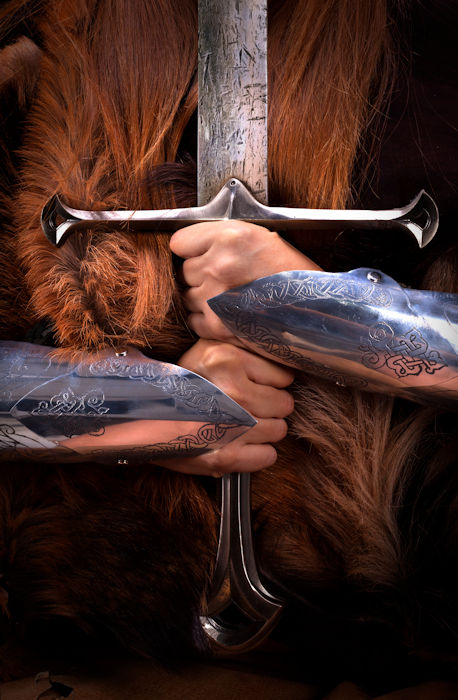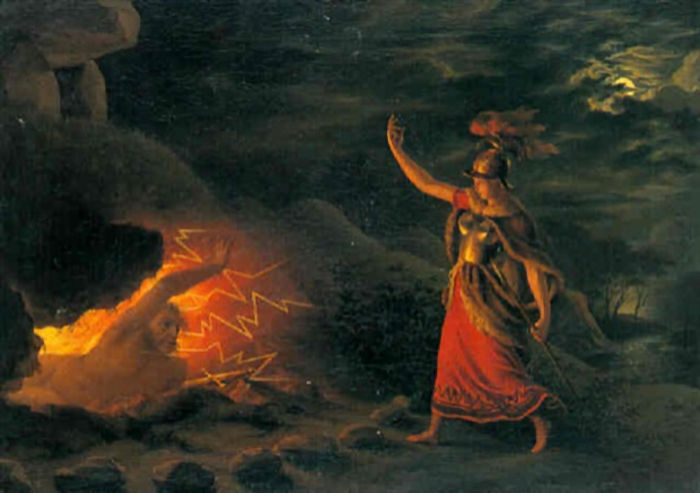Ellen Lloyd – AncientPages.com – We encounter Hervör in the Saga of Hervör and Heidrek, which originates from the thirteenth century and combines elements from several older sagas.
It is easy to be a little confused when reading about Hervör because two female characters share the name in the saga. One of the females is a commander killed in battle with her brother. The other Hervör is the daughter of Angantyr, who went on a dangerous journey in search of the cursed sword Tyrfing.
Most scholars agree these two women are the same individuals. In this article, we will tell the story by looking through the eyes of the latter.

Hervör was a woman who knew what she wanted, and no one could top her once she decided on something. Credit: Adobe Stock – Mattia
Hervör – A Beautiful But Troublesome Girl
From being a small child with no parents, Hervör grew up and became a beautiful lady who was as strong as the boys and more courageous than most adults. Whether she was a good person can be debated, though.
The Saga of Hervör and Heidrek is known from 13th- and 14th-century parchment sources and 17th-century paper manuscripts.
Like most Norse Sagas, it is a piece of literature focusing on heroism and battles, mixed with supernatural elements that give the tale a more magical atmosphere. It is no wonder the fascinating saga influenced J. R. R. Tolkien when he shaped his Middle-Earth legends.
From the saga, we learn that Hervör was no ordinary young lady. She was the daughter of Angantyr, who died during a duel against the Swedish hero Hjalmar. The young girl was beautiful, and she was brought up in the house of Jarl Bjarmar.
It is said that she “was as strong as a man; as soon as she could do anything for herself she trained herself more with bow and shield and sword than with needle-work and embroidery. She did more often harm than good, and when it was forbidden her she ran away to the woods and killed men for her gain.” 1
Hervör was what we would today refer to as a tomboy. She dressed in male clothes and learned archery, swordsmanship, and horse riding. She disguised her female idenтιтy and fought, killed, and pillaged under her male surname Hjörvard.
Hervör learned about the fate of her father accidentally. According to the saga, she was not kind and often mistreated people. One day while standing next to a group of slaves, she was mean to them as always and they lost patience with her. One of them said: “Your only wish is to do evil, Hervör, and evil is to be expected from you; the jarl forbids everyone to speak to you of your parentage, because he is ashamed that you should know of it—for the basest serf lay with his daughter, and you are their child.’ 1
When Hervör heard this, she was enraged and went straight away to the Jarl, demanding to know the truth about her father.
She was told her father, Angantyr the Berserker, once possessed the magic sword Tyrfing, which was “invincible to any warrior who fought with it. Tyrfing was always shining brightly, just like the Sun, and every time its edge was uncovered, someone got killed. No living creature could survive even the slightest wound made by the sword.

Svafrlami secures the sword Tyrfing. Image credit: Author: Lorenz Frølich (1820–1908). Source – Rydberg, Viktor. 1906. Teutonic Mythology Vol. III.Rydberg, Viktor. 1906
It was commonly believed that Tyrfing was forged and cursed by the dwarves Dvalinn and Durin for king Svafrlami, one of Odin‘s sons. Dwarves were well-known for their outstanding ability to produce remarkable weapons.” 2
In Norse mythology, many stories tell how gods relied on magical weapons and other curious objects to become rich, invisible, shape-shift, conquer the enemy or strike fear into the hearts of individuals. Many of these amazing were indeed manufactured by the dwarves, and these tiny little creatures were intelligent, skilled, and sometimes very cunning. As previously mentioned on Ancient Pages, the Sons of Ivaldi made Gungnir, Odin’s magical weapon that never missed its target, and Skidbladnir, a magic ship.
The dwarves Brokkr and Eitri created the Draupnir ring, Mjölnir hammer, and Gullinbursti.
Hervör’s Journey To The Haunted Island And Encounter With A Ghost
Once shieldmaiden Hervör had learned about the incredible Tyrfing sword, she decided to find it.
The dramatic story featuring Hervör’s dangerous journey to obtain the sword is described in the poem “The Waking of Angantýr.”
Hervör understands her father, Angantyr the berserk, and his death on the island of Sámsey holds the key to the mystery of the Tyrfing sword. Being a courageous woman, she sails with her fleet to the haunted island, but none except herself dares to go ashore. Her crew is terrified of the nightly activities around the barrows on the island. She is told a fire burns over treasure hidden in the burial mound, and evil forces guard the grounds.
Naturally, this did not stop Hervör, who was never afraid, and she headed straight for the burial mound.

Coming in contact with the Tyrfing sword could only end badly. Credit: Adobe Stock – Marko Stamatovic
“Now Hervör saw where out upon the island burned the fire of the barrows, and she went towards it without fear, though all the mounds were on her path. She made her way into these fires as if they were no more than mist until she came to the barrow of the berserks.” 1
She sees the fire above the barrow and speaks loudly, summoning her father, Angantyr to reveal himself. Hervör says she is his daughter and is enтιтled to the inheritance, the Tyrfing sword.

Hervör wakes her father Angantýr’s ghost from his barrow to demand the cursed sword Tyrfing. Credit: Painting by Christian Gottlieb Kratzenstein-Stub (1783–1816). Public Domain
“Wake, Angantýr, wakes you Hervör, Sváfa’s offspring, your only daughter; the keen-edged blade from the barrow give me, the sword dwarf-smithied for Sigrlami,” she boldly declares.
After a while, she hears a father’s voice asking her not to pursue her quest, but Hervär refuses to give up on the sword.
Finally, the grave opens, and she can see a fire in the center of the mound and her father standing next to the flames.
He tells Hervör she should forget about the sword because it is cursed and will only bring misfortunes to her and her people, but she ignores the warning. She is persistent and says she must have the Tyrfing sword.
Hervör wins this debate, and the Tyrfing sword is cast out of the grave. She grabs it quickly and hurries back to the shore, only to see her fleet is gone. There are no ships and sight, and she understands her crew fled, being scared away by the fires and the thunder from the barrows.
Once Hervör succeeded in leaving the haunted island, she resumes her Viking activities. Dressed as a man, she calls herself Hjörvard and travels to distant lands. One day she grows tired of her adventures and returns home. She marries to King Gudmund’s son Höfund, and the couple has two sons.
The ghost of Hervör’s father warned her that the Tyrfing sword would cause sadness, and those were true words. Her son Heidrek killed his brother Angantyr with the cursed Tyrfing sword!
The Waking of Angantýr – A Spooky Poem
The Waking of Angantýr is a powerful and scary poem that can be regarded as a Norse ghost story.
“The dialogue between Hervör and Angantyr, despite a certain melodramatic element in the setting, is treated with great delicacy and poetic feeling, and an atmosphere of terror and mystery pervades the whole poem. The midnight scene in the eerie and deserted burial-ground, the lurid flickering of the grave fires along the lonely beach, the tombs opening one by one as the corpses start to life — all these work on the imagination and create an atmosphere of dread.
The poet understood the technique of presenting the supernatural, and he is deliberately vague and suggestive. Much more is implied than is stated, and much is left to the imagination.” 2
Hervör’s quest for the cursed Tyrfing sword is a tale about courage, stubbornness, and honor mixed with spooky supernatural elements, making the story just as terrifying as captivating.
Updated on January 20, 2024
Written by Ellen Lloyd – AncientPages.com
Copyright © AncientPages.com All rights reserved. This material may not be published, broadcast, rewritten or redistributed in whole or part without the express written permission of AncientPages.com
Expand for references
- Christopher Tolkien – The Saga of King Heidrek the Wise
- Delphi Classics – Delphi Collected Norse Sagas
- Ellen Lloyd – Tyrfing And Gram: Two Magical Swords And Hervor’s Death In Norse Mythology, AncientPages.com





